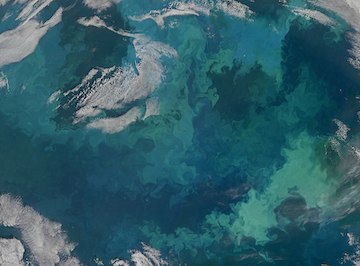color of ocean.jpg

The blue-green swirls in the photo are actually millions of tiny phytoplankton floating in the sea. Photo Credit: NASA/ Creative Commons Attribution 2.0 Generic
If you like the deep blues and rich blue-greens of the oceans, then you might really enjoy the view at the end of the century. A recent study says the blues could be bluer and the greens greener. While that might be aesthetically pleasing, it's not a good thing for life.
A couple of factors determine ocean color: the water itself, and the stuff it contains. Water molecules absorb redder wavelengths of light and reflect bluer wavelengths, making water look blue.
But that color is altered by the stuff in the water. Tiny plant-like organisms known as phytoplankton, for example, add a greenish tint. That's because they contain chlorophyll -- the compound that gives plants on land their green color. So the more phytoplankton, the greener the water.
Researchers created a model of how ocean colors might change through the end of the century. The model included changes in temperature, chemistry, and other factors.
They found that a global temperature rise of about five degrees Fahrenheit would change the amount of phytoplankton in the oceans. In some areas, there would be more or different phytoplankton, making the water look greener. In other regions, there would be fewer phytoplankton, making the water bluer.
The problem is that phytoplankton are at the bottom of the marine food chain -- they're eaten by larger organisms, which are eaten by even larger organisms, and so on. So changes in phytoplankton would be more than cosmetic -- they could affect life in all the world's oceans.

